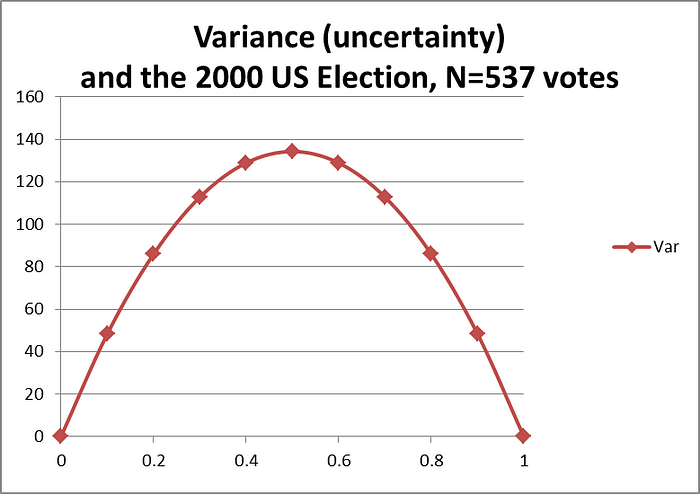The Beauty of “1/2”

It was from biology, after studying mitosis and meiosis, and observing their natural biological beauty during genetics research, that I gained a genuine respect for the impacts that a simple fraction like “1/2” has had upon our natural world. Imagine our lives without the energy devoted to growth and repair via mitosis. Humans, and all eukaryotes that reproduce sexually, depend upon the alternation between 2N chromosomes and 1N during cell cycles for perpetuating their species over generations. While the underlying evolutionary forces are no different, other animals and higher plants, go about maintaining a balance in their unique ways.
Organic evolution is only one of many phenomena that humans have uncovered which rely upon “1/2”. Imagine Euclidean geometry without being able to find the area of a circle: Area= πr2, where the radius “r” is 1/2 the diameter. Or, the area of a right triangle, Area=1/2(Height)٠(Base).
I am not suggesting that “1/2” is of the same status as pi and e, the two best known transcendental numbers. It is obvious to me, however, that such a simple fraction does hold a significant position amongst constants that we rely upon to solve answers to questions about our natural world and to better understand our reality.
Our cumulative knowledge, in my opinion, of whom we are as sentient beings and where we think that we fit into this Universe is founded upon humans having designed numbers, alphabets and the sciences that evolved from our being very curious animals over these past millions of years. Why is so many of the essential processes in our biological world founded upon ½? Why not another fraction or, why even a fraction?
Refer to Table 1 for a list of some commonly recognized processes: this is likely an incomplete accounting. I have assigned each example to Organic or Inorganic or both: each is also subject to arguments for and against my choices.
These are only some of the examples of when “1/2” can be found the underlying factor or coefficient that defines or drives a process.
1. Organic: Mitosis
“Mitosis is a process of nuclear division in eukaryotic cells that occurs when a parent cell divides in half to produce two identical daughter cells. During cell division, mitosis refers specifically to the separation of the duplicated genetic material carried in the nucleus. Today, mitosis is understood to involve five phases, based on the physical state of the chromosomes and spindle. These phases are prophase, prometaphase, metaphase, anaphase, and telophase. Cytokinesis is the final physical cell division that follows telophase, and is therefore sometimes considered a sixth phase of mitosis.”
https://www.nature.com/scitable/definition/mitosis-cell-division-47/
https://www.nature.com/scitable/topicpage/mitosis-and-cell-division-205/
https://en.wikipedia.org/wiki/Human_embryonic_development
2. Organic: Meiosis
Meiosis produces 4 haploid germ cells following 2 halving events.
https://www.nature.com/scitable/topicpage/meiosis-genetic-recombination-and-sexual-reproduction-210/ ;
3. Organic: Biological Fission (asexual)
Bacteria; after elongating, a fissure forms in the parent cell followed by halving into 2 new cells after the replication of DNA.
Organic Barr bodies 50% of the female X-chromosomes are inactivated, leaving the same number/cell as in the male cells.
http://issues-big-and-small.blogspot.com/2014/03/thewomen-get-one-x-knocked-out-and-yes.html
4. Organic: Sex Ratio
For each mammalian birth, the chance of a Girl or Boy is 0.50. Probability that a family will have 8 children and all or girls: (0.50)⁸ = 0.0039. The same holds true if all were boys. Therefore, among 10,000 families with 8 children, we would expect 39 families to produce all of one sex.
http://issues-big-and-small.blogspot.com/2014/03/sortinggeneskeeping-girls-and-boys.html;
https://genetics.thetech.org/ask-a-geneticist/can-sons-or-daughters-run-family
5. Organic: Genetic Inheritance by generation (1/2)^n
My genome is 50% my mother’s and 50% my fathers (click to see my recent post). Two generations before I had 2 maternal grandparents and 2 paternal. Therefore, my genome contains 25% of each of 4 grandparents: each transmission event is ½^n, likewise the same for brothers and/or sisters of my parents.
https://customercare.23andme.com/hc/en-us/articles/212170958-DNA-Relatives-Detecting-Relatives-and-Predicting-Relationships https://www.nature.com/scitable/topicpage/inheritance-of-traits-by-offspring-follows-predictable-6524925/ ;
6. Organic/Inorganic: Diversity in biology and Uncertainty in politics
In a Two party political system: diversity comes with the uncertainty caused by near 50:50 outcomes https://www.britannica.com/topic/two-party-system .
See also — — http://issues-big-and-small.blogspot.com/2014/04/diversityand-politicsthe-good-and-bad.html
When P1~P2, then uncertainly is maximum in a 2 -party system. That appears the case today in the USA. Uncertainty) is maximum for any Pn when the frequency of all categories in the population are equal. We witnessed the effects in the 2000 US presential election: 266 vs 271 electoral votes: Republicans took the White House, barely, after much descension.

Species Diversity
https://en.wikipedia.org/wiki/Diversity_index

7. Inorganic and Organic: Half-Life of radioisotopes and legal/illegal drugs.
https://en.wikipedia.org/wiki/Half-life ;
and see also: https://www.ncbi.nlm.nih.gov/books/NBK554498/
8. Inorganic: The Riemann hypothesis
“In mathematics, the Riemann hypothesis is a conjecture that the Riemann zeta function has its zeros only at the negative even integers and complex numbers with real part 1/2. … These are called its trivial zeros. The zeta function is also zero for other values of s, which are called nontrivial zeros.”
9. Inorganic: Binary Stars
Calculating the center of mass in binary stars… “In a simple binary case, r1, the distance from the center of the first star to the center of mass (a radius) or barycenter, is given by…”
10. Inorganic: Geometry of a circle and triangle
Recall that for a circle, r=1/2 D, where “r” is the radius and “D” is the diameter”.
https://en.wikipedia.org/wiki/Area_of_a_circle
Area of a triangle= ½*(Base)٠(Height)
https://en.wikipedia.org/wiki/Triangle?wprov=sfla1
11. Inorganic: Comparing Fractions using ½
https://www.mathcoachscorner.com/2015/06/comparing-fractions-using-a-benchmark-of-12/
Inorganic: Distance in Euclidian space
https://en.wikipedia.org/wiki/Distance
12. Inorganic: Median vs Mean
https://www.diffen.com/difference/Mean_vs_Median
13. Inorganic: Calculating the nth root
“…the square root of X is written: X^¹/² “.
Nth root: ”Every positive real number x has a single positive nth root, called the principal nth root, which is written For n equal to 2 this is called the principal square root and the n is omitted. The nth root can also be represented using exponentiation as x¹/n. “
14. Inorganic: Beam scale, Equal arms:
A special application where cotton was grown in the US (part of the author’s memory):

